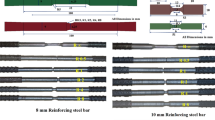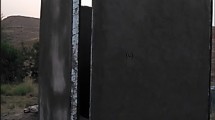Abstract
In the present study, a numerical model is developed for investigating the capacity of the Carbon Fiber Reinforced Polymer (CFRP) patch to improve the blast response of cracked reinforced concrete (RC) slab. The model uses a finite element method adopted by LS-DYNA. To achieve this aim, a 3D nonlinear Finite-element (FE) model is developed to study the blast resistance of cracked RC slab with and without external reinforcement by CFRP. After model validation, the blast response of the cracked RC slabs with several different crack parameters (e.g. orientation, width and depth) under the blast loading is firstly studied. Then to improve the blast resistance, the cracked RC slabs are stiffened by CFRP composite patches. Numerical results show that the repaired patches can significantly reduce the mid-span deflection and improve the damage distribution of the cracked RC slab. The CFRP is proved to be a valid solution for repairing of cracked RC slab and can increase the blast resistance of RC structures under blast loading. Finally, a parametric analysis is further conducted to investigate the influences of the layer number and layer size of the CFRP patch on the blast resistance of the retrofitted model.
Similar content being viewed by others
References
Béton CE-Id (1993). CEB-FIP model code 1990: Design code, Redwood Books, Trowbridge, Wiltshire, UK.
Brighenti, R. (2005). “Numerical buckling analysis of compressed or tensioned cracked thin plates Engineering Structures.” Engineering Srtuctures, Vol. 27, No. 2, pp. 265–276, DOI: 10.1016/j.engstruct.2004.10.006.
Chen, W. S. and Hao, H. (2012). “Numerical study of a new multi-arch double-layered blast-resistance door panel.” International Journal of Impact Engineering, Vol. 43, pp. 16–28, DOI: 10.1016/j.ijimpeng.2011.11.010.
Colombi, P. and Fava, G. (2015). “Experimental study on the fatigue behaviour of cracked steel beams repaired with CFRP plates.” Engineering Fracture Mechanics, Vol. 145, pp. 128–142, DOI: 10.1016/j.engfracmech.2015.04.009.
Crawford, J. E., Malvar, J. E., Morrill, K. B., and Ferrito, J. M. (2001). “Composite retrofits to increase the blast resistance of reinforced concrete buildings.” Proceedings of the 10th international symposium on interaction of the effects of munitions with structures, San Diego, SD.
Hao, J. B., Li, X. D., and Mu, Z. T. (2015). “Fatigue behavior of thick center cracked aluminum plates repaired by two-sided composite patching.” Materials & Design, Vol. 88, pp. 331–335, DOI: 10.1016/J.MATDES.2015.09.011.
Hudson, J. L. and Darwin, D. (2005). Evaluation and repair of blast damaged reinforced concrete beams, A Report on Research Sponsored by the University of Kansas, Structural Engineering and Materials Laboratory.
Joint Depts. of the Army, the Navy, and the Air Force (1990). “Structures to resist the effects of accidental explosions.” Technical Manual(TM 5-1300/NAVFAC P-397/AFR 88-22), Washington, DC.
Krauthammer, T. (1999). “Blast-resistant structural concrete and steel connections.” International Journal of Impact Engineering, Vol. 22, No. 9-10, pp. 887–910, DOI: 10.1016/S0734-743X(99)00009-3.
Li, J. and Hao, H. (2013). “Influence of brittle shear damage on accuracy of the two-step method in prediction of structural response to blast loads.” International Journal of Impact Engineering, Vol. 54, pp. 217–231, DOI: 10.1016/j.ijimpeng.2012.11.008.
Lin, X. S., Zhang, Y. X., and Hazell, P. J. (2014). “Modelling the response of reinforced concrete panels under blast loading.” Material & Design, Vol. 56, pp. 620–628, DOI: 10.1016/j.matdes.2013.11.069.
LS-DYNA (2007). LS-DYNA keyword user’s manual, version 971. Livermore Software Technology Corporation, Livermore, California, L.C.
Luccioni, B. M. and Luege, M. (2006). “Concrete pavement slab under blast loads.” International Journal Impact Engineering, Vol. 32, No. 8, pp. 1248–1266, DOI: 10.1016/j.ijimpeng.2004.09.005.
Malvar, L. J, Crawford, J. E, Wesevich J. W, and Simons, D. (1997). “A plasticity concrete material model for DYNA3D.” International Journal Impact Engineering, Vol. 19, Nos. 9-10, pp.847–873, DOI: 10.1016/S0734-743X (97) 00023-7.
Malvar, L. J. and Crawford, J. E. (1998). Dynamic increase factors for steel reinforcing bars, 1st ed, In: 28th DDESB seminar, Orlando, USA.
Malvar, L. J. and Ross C. A. (1998). “Review of strain rate effects for concrete in tension.” Aci Materials Journal, Vol. 95, No. 5, pp. 609–616.
Mosalam, K. M. and Mosallam, A. S. (2001). “Nonlinear transient analysis of reinforced concrete slabs subjected to blast loading and retrofitted with CFRP composites.” Composites Part B: Engineering, Vol. 32, No. 8, pp. 623–636, DOI: 10.1016/S1359-8368(01)00044-0.
Mou, H. L., Zhou, T. F., and Chen, Y. F. (2015). “Simulation and experimental analysis of composite corrugated plate quasi-static crushing.” Mechanical Science and Technology for Aerospace Engineering, Vol. 34, No. 4, pp. 618–622, DOI: 10.13433/j.cnki.1003-8728.2015.0426.
Myers, J. J., Belardi, A., and El-Domiaty, K. A. (2004). “Blast resistance of FRP retrofitted unreinforced masonry (URM) walls with and without arching actions.” Masonry Soc J, Vol. 22, No. 1, pp. 9–26.
Paik, J. K., Satish Kumar, Y. V., and Lee, J. M. (2005). “Ultimate strength of cracked plate elements under axial compression or tension.” Thin-Walled Structures, Vol. 43, No. 2, pp. 237–272, DOI: 10.1016/j.tws.2004.07.010.
Pan, J. L., Zhou, J. J., and Luo, M. (2011). “Numerical simulations on dynamic responses of FRP strengthened reinforced concrete twoway slabs under blasting loading.” Journal of PLA University of Science and Technology, Vol. 12, No. 6, pp. 643–648, DOI: 10.7666/j.issn.1009-3443.201106016.
Randers-Pehrson, G. and Bannister, K. A. (1997). Air blast loading model for DYNA2D andDYNA3D ARL-TR-1310, Adelphi MD: Laboratory AR., Ed. USA.
Shi, Y. C., Hao, H., and Li, Z. X. (2008). “Numerical derivation of pressure–impulse diagrams for prediction of RC column damage to blast loads.” International Journal Impact Engineering, Vol. 35, No. 11, pp. 1213–1227, DOI:10.1016/j.ijimpeng.2007.09.001.
Sun, W. B. (2009). “Experimental studies on Reinforced Concrete (RC) slabs subjected to blast loads.” Joural of Liaoning Technical University, Vol. 28, pp. 217–220, DOI: 10.3969/j.issn.1008-0562.2009.02.016.
Tai, Y. S., Chu, T. L., Hu, H. T., and Wu, J. Y. (2011). “Dynamic response of a reinforced concrete slab subjected to air blast load.” Theoretical Applied Fracture Mechanics, Vol. 56, No. 3, pp. 140–147, DOI: 10.1016/j.tafmec.2011.11.002.
Thanoon, W. A., Jaafar, M. S., Kadir, M. R. A., and Noorzaei, J. (2005). “Repair and structural performance of initially cracked reinforced concrete slabs.” Construction and Building Materials, Vol. 19, No. 8, pp. 596–603, DOI: 10.1016/j.conbuildmat.2005.01.011.
Wang, W., Zhang, D., Lu, F. Y., Wang, S. C., and Tang, F. J. (2012). “Experimental study on scaling the explosion resistance of a oneway square reinforced concrete slab under a close-in blast loading.” International Journal Impact Engineering, Vol. 49, pp. 158–164, DOI: 10.1016/j.ijimpeng.2012.03.010.
Wang, W., Zhang, D., Lu, F., Wang, S. C., and Tang, F. (2013). “Experimental study and numerical simulation of the damage mode of a square reinforced concrete slab under close-in explosion”. Engineering Failure Analysis, Vol. 27, No. 1, pp. 41–51, DOI: 10.1016/j.engfailanal.2012.07.010.
Wu, C., Oehlers, D. J, Rebentrost, M., Leach, J., and Whittaker, A. S. (2009). “Blast testing of ultra-high performance fibre and FRPretrofitted concrete slabs.” Engineering Structures, Vol. 31, No. 9, pp. 2060–2069, DOI: 10.1016/j.engstruct.2009.03.020.
Xu, K. and Lu, Y. (2006). “Numerical simulation study of spallation in reinforced concrete plates subjected to blast loading.” Computers Structures, Vol. 84, Nos. 5-6, pp. 431–438, DOI: 10.1016/j.compstruc.2005.09.029.
Yang, J. L., Zhang, Y., and Yu, T. X. (1992). “An experimental study of imperfect clamped beams subjected to impact.” Explosion Shock Waves, Vol. 12, pp. 22–29. (In Chinese).
Yuan, L., Gong, S. F., and Jin, W. L. (2008). “Spallation mechanism of RC slabs under contact detonation.” Transaction of Tianjin University, Vol. 14, No. 6, pp. 464–469, DOI: 10.1007/s12209-008-0079-6.
Zhao, C. F. and Chen, J. Y. (2013). “Damage mechanism and mode of square reinforced concrete slab subjected to blast loading.” Theoretical and Applied Fracture Mechanics, Vol. 63-64, pp. 54–62, DOI: 10.1016/j.tafmec.2013.03.006.
Zhao, S. Y. and Xue, P. (2014). “New two-dimensional polynomial failure criteria for composite materials.” Advances in Materials Science & Engineering, Vol. 2014, No. 3, pp. 1–7, DOI: 10.1155/2014/503483.
Zhou, X. Q., Kuznetsov, V. A., Hao, H., and Waschl, J. (2008). “Numerical prediction of concrete slab response to blast loading.” International Journal of Impact Engineering, Vol. 35, No. 10, pp. 1186–1200, DOI: 10.1016/j.ijimpeng.2008.01.004.
Author information
Authors and Affiliations
Corresponding author
Rights and permissions
About this article
Cite this article
Kong, X.Q., Zhao, Q., Qu, Y.D. et al. Blast Response of Cracked Reinforced Concrete Slabs Repaired with CFRP Composite Patch. KSCE J Civ Eng 22, 1214–1224 (2018). https://doi.org/10.1007/s12205-017-1054-3
Received:
Revised:
Accepted:
Published:
Issue Date:
DOI: https://doi.org/10.1007/s12205-017-1054-3




